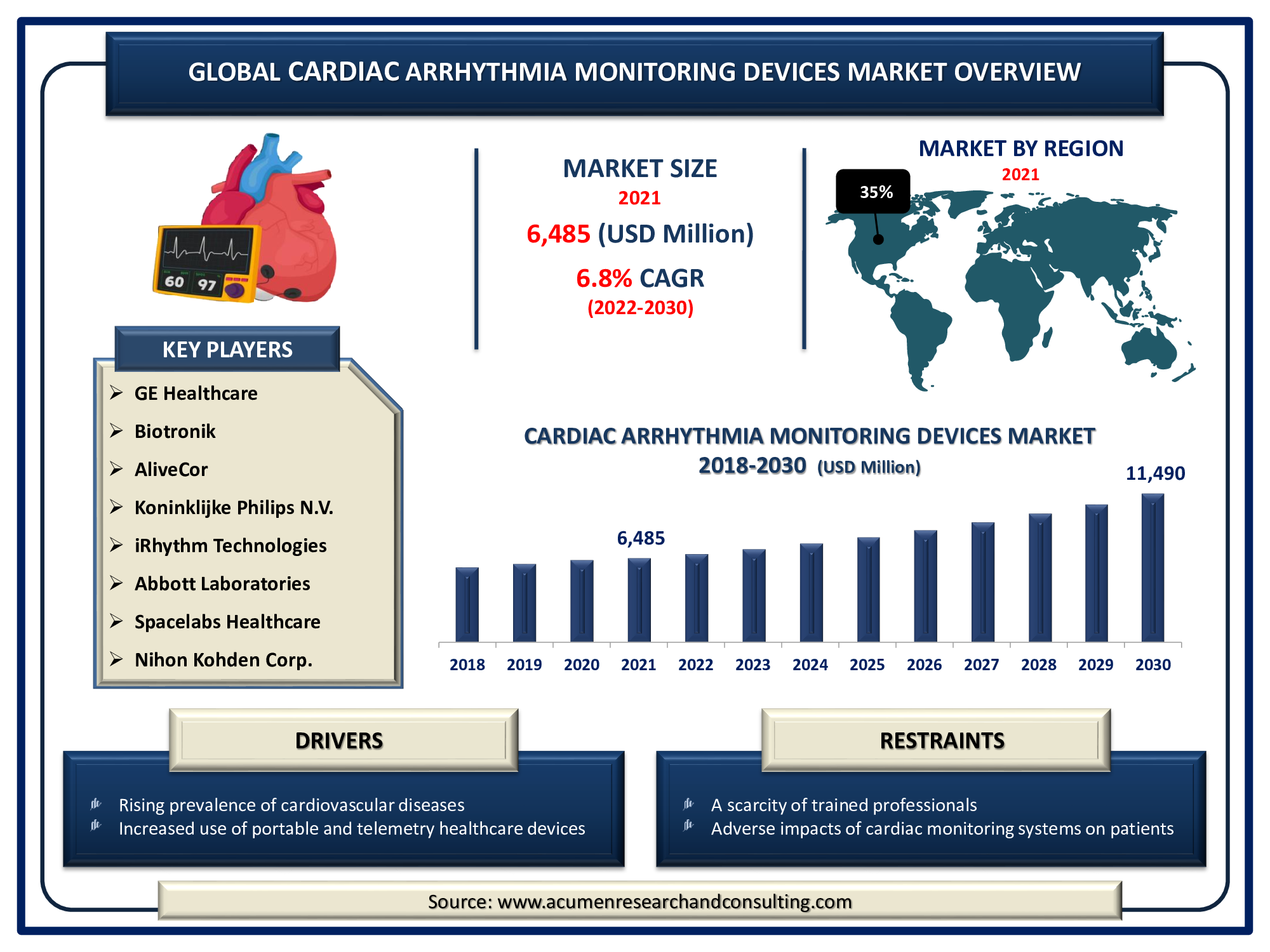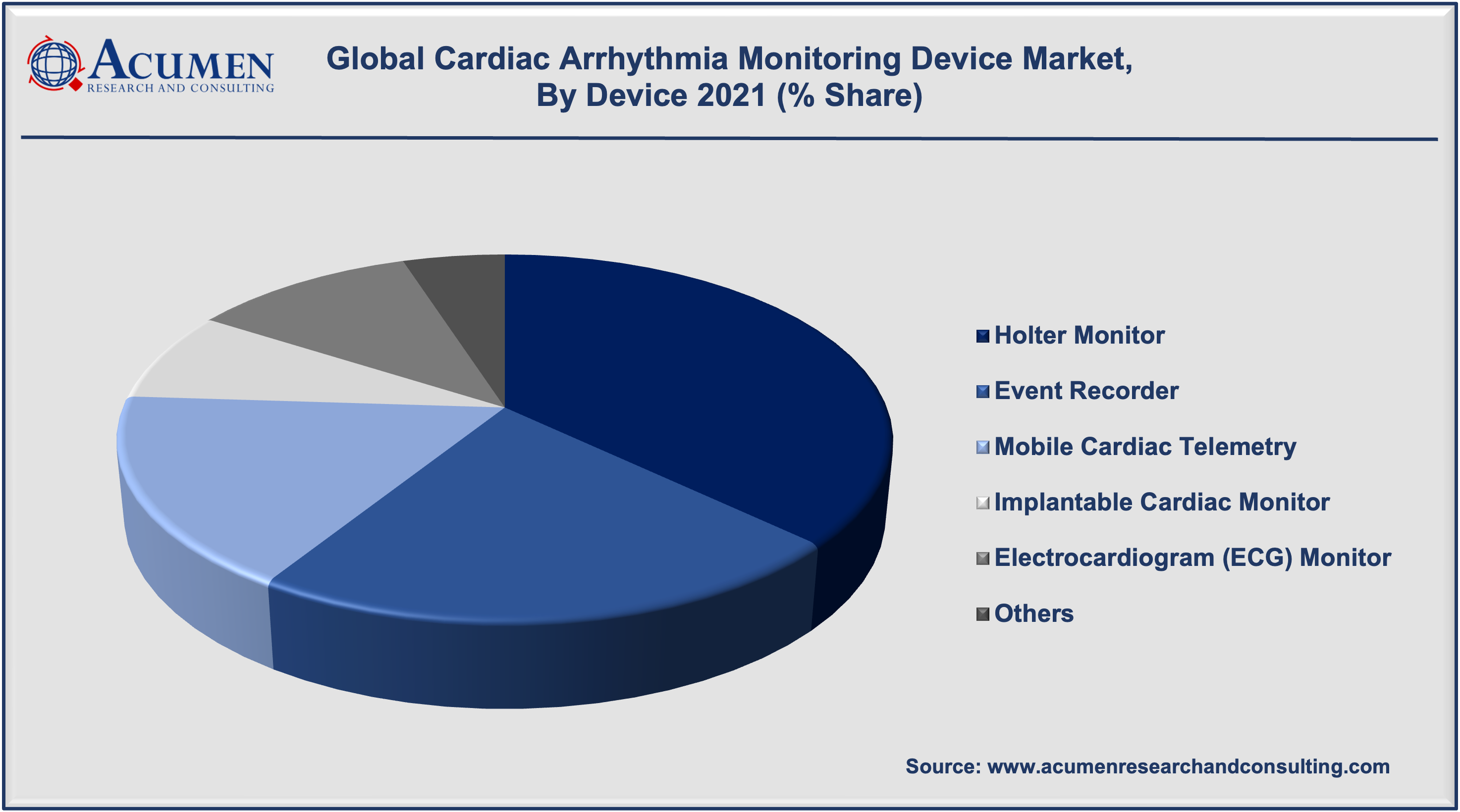Cardiac Arrhythmia Monitoring Devices Market Analysis - Global Industry Size, Share, Trends and Forecast 2022 - 2030
Published :
Report ID:
Pages :
Format :
Cardiac Arrhythmia Monitoring Devices Market Analysis - Global Industry Size, Share, Trends and Forecast 2022 - 2030
Report Coverage
- Industry Dynamics
- Market Size and Forecast Data
- Segment Analysis
- Competitive Landscape
- Regional Analysis with a Niche Focus on Country-Level Data
- High Level Analysis - Porter's, PESTEL, Value Chain, etc.
- Company Profiles of Key Players
- Option to Customize the Report As Per Your Specific Need
Request Sample Report
The Global Cardiac Arrhythmia Monitoring Devices Market size accounted for USD 6,485 Million in 2021 and is expected to reach USD 11,490 Million by 2030 with a considerable CAGR of 6.8% during the forecast timeframe of 2022 to 2030.

Arrhythmia is a condition characterized by abnormal cardiac activity, which occurs when the heart beats too slowly, too rapidly, too frequently, or unevenly. Cardiac arrhythmia monitoring devices are used to track the heart's activity, keeping a record of it and assisting in the reporting of any deviations from the normal rhythm. Some cardiac arrhythmia monitoring devices are mobile cardiac telemetry, resting ECG, Holter monitor, event monitoring, and implantable cardioverter monitor. The increased demand for cardiac arrhythmia monitoring devices among patients and healthcare organizations is mostly due to an increase in the prevalence of cardiovascular diseases as well as demographic changes in lifestyle. However, the rising frequency of cardiovascular disorders and global expenditure on cardiac health are stifling the global cardiac arrhythmia monitoring devices market.
Cardiac Arrhythmia Monitoring Devices Market Dynamics
Drivers
- Rising prevalence of cardiovascular diseases
- Emerging technologies and the development of novel heart rhythm monitoring devices
- Increased use of portable and telemetry cardiac monitoring
- The growing geriatric population combined with rising obesity rates
Restraints
- A scarcity of trained professionals
- Adverse impacts of some cardiac monitoring systems on patients
Opportunity
- Increasing spending on cardiovascular health globally
- Increasing consumer acceptance of homecare settings
Report Coverage
| Market | Cardiac Arrhythmia Monitoring Devices Market |
| Market Size 2021 | USD 6,485 Million |
| Market Forecast 2030 | USD 11,490 Million |
| CAGR During 2022 - 2030 | 6.8% |
| Analysis Period | 2018 - 2030 |
| Base Year | 2021 |
| Forecast Data | 2022 - 2030 |
| Segments Covered | By Device, By Application, By End-user, And By Geography |
| Regional Scope | North America, Europe, Asia Pacific, Latin America, and Middle East & Africa |
| Key Companies Profiled | GE Healthcare, Applied Cardiac Systems, Inc., Biotronik, AliveCor, Koninklijke Philips N.V., iRhythm Technologies, Abbott Laboratories, Spacelabs Healthcare, Nihon Kohden Corporation, Medtronic plc, Biotricity, and Welch Allyn-Hillrom Services, Inc. |
| Report Coverage |
Market Trends, Drivers, Restraints, Competitive Analysis, Player Profiling, Regulation Analysis |
| Customization Scope |
10 hrs of free customization and expert consultation |
Recent innovations in cardiac arrhythmia monitoring devices, rising cardiovascular disease rates, favorable reimbursement rates for cardiac condition therapy, and a growing emphasis on healthcare cost containment are important drivers driving the cardiac arrhythmia monitoring devices market revenue. Furthermore, increased adoption of low-cost ECG services among the lower-income segment, as well as favorable government regulations for tech startups, are driving worldwide cardiac arrhythmia monitoring devices market trends. The greater reliance on technical discoveries and advances for alternative possibilities, on the other hand, threatens to disrupt market growth. In addition, an increase in device recall of cardiac monitoring systems and issues associated with all these devices may have a negative impact on market growth. Patient-activated equipment will only grasp symptomatic incidences that the patient acknowledges.
The COVID outbreak has increased the demand for remote patient monitoring of people with cardiovascular diseases. This modification was made to reduce the risk of contamination caused by the recurrent hospital and other healthcare consults. Several companies have launched virtual cardiac patient monitoring systems. For example, Octagos Health has launched a telemonitoring software interface that enables professionals and cardiovascular electrophysiologists to view all of their patients' implantable cardioverter device information in real-time.
Cardiac Arrhythmia Monitoring Devices Market Segmentation
The global cardiac arrhythmia monitoring devices market segmentation is based on device, application, end-user, and region.
Market by Device
- Holter Monitor
- Electrocardiogram (ECG) Monitor
- Event Recorder
- Implantable Cardiac Monitor
- Mobile Cardiac Telemetry
- Others

In terms of equipment, the Holter monitor sector dominated the market in 2021. A Holter monitor is a small electrocardiograph device that captures the heart activity of a patient in real-time. It is the size of a typical camcorder and has cables linked to the skin with electrodes the size of silver dollars. Depending on the type of monitoring used, a battery-powered Holter monitor can function correctly for 48 hours or longer. The growing emphasis on the expansion of knowledge in the usage of Holter monitoring equipment is projected to present market participants with appealing growth opportunities. Furthermore, there is a growing demand for implantable cardioverter monitoring. An implanted groove transmitter delivers more data than a Holter monitor and allows for long-term heart rhythm monitoring.
Market by Application
- Tachycardia
- Atrial Tachycardia
- Ventricular Tachycardia
- Bradycardia
- Premature Contraction
- Others
Based on the application, the tachycardia segment is projected to expand at the fastest rate over the coming years. Tachycardia is a common type of cardiac disease characterized by a fast heartbeat. Tachycardia can be caused by a number of conditions, including heart disease, particularly coronary heart disease, excessive alcohol intake, and health issues such as thyroid problems and several lung maladies. The segment is further subdivided into atrial and ventricular tachycardias. The growing use of a variety of technological solutions for illness monitoring is likely to drive up demand for tachycardia monitoring systems in the coming years. Furthermore, cardiac arrhythmia monitoring systems play an important role in disease diagnosis and therapy. As a result of the rising incidence of tachycardia, the cardiac arrhythmia monitoring equipment market is expected to expand significantly in the near future.
Market by End-User
- Hospitals and Clinics
- Homecare Settings
- Ambulatory Surgical Centers
- Diagnostic Centers
- Others
In terms of end-user, hospitals and clinics are likely to dominate the market in 2021. The rising global incidence of heart arrhythmia, paired with an older population, will increase hospital admission rates for treatment. Modern scientific and technological developments in the category, as well as a spike in the proportion of older citizens suffering from cardiac difficulties, are all helping to drive the segment's growth. Furthermore, the increasing prevalence of cardiovascular disease, the increasing proportion of outpatient hospital visits for diagnosis, the growing amount of cardiovascular implant treatments, and the accessibility of reimbursement for such treatments in developed markets all contributes to the size of this segment.
Cardiac Arrhythmia Monitoring Devices Market Regional Overview
North America
- U.S.
- Canada
Europe
- U.K.
- Germany
- France
- Spain
- Rest of Europe
Latin America
- Mexico
- Brazil
- Rest of Latin America
Asia-Pacific
- India
- Japan
- China
- Australia
- South Korea
- Rest of Asia-Pacific
The Middle East & Africa (MEA)
- Gulf Cooperation Council (GCC)
- South Africa
- Rest of the Middle East & Africa
The North American region will hold a substantial cardiac arrhythmia monitoring devices market share over the projected period due to factors such as the emergence of strong competitors, a growing elderly population, and a favorable reimbursement strategy. Moreover, owing to the increased use of novel cardiovascular treatments and improved medical infrastructure, the market for cardiac arrhythmia monitoring devices in North America is likely to grow substantially. Additionally, significant technological advances in the industry's geographical landscape are positively influencing the growth of the global cardiac arrhythmia monitoring devices market throughout the forecast period. Besides that, the growing prevalence of Atherosclerosis, rising healthcare awareness, rising discretionary income, rising healthcare expenditure, and the accessibility of technologically sophisticated technologies in the region all contribute to this market segment's size.
Cardiac Arrhythmia Monitoring Devices Market Players
Some of the world's most prominent cardiac arrhythmia monitoring devices market companies are GE Healthcare, Applied Cardiac Systems, Inc., Biotronik, AliveCor, Koninklijke Philips N.V., iRhythm Technologies, Abbott Laboratories, Spacelabs Healthcare, Nihon Kohden Corporation, Medtronic plc, Biotricity, and Welch Allyn-Hillrom Services, Inc.
Frequently Asked Questions
How much was the market size of global cardiac arrhythmia monitoring devices market in 2021?
The estimated market size of global cardiac arrhythmia monitoring devices market in 2021 was USD 6,485 Million.
What will be the projected CAGR for global cardiac arrhythmia monitoring devices market during forecast period of 2022 to 2030?
The projected CAGR of cardiac arrhythmia monitoring devices during the analysis period of 2022 to 2030 is 6.8%.
Which are the prominent competitors operating in the market?
The prominent players of the global cardiac arrhythmia monitoring devices market involve GE Healthcare, Applied Cardiac Systems, Inc., Biotronik, AliveCor, Koninklijke Philips N.V., iRhythm Technologies, Abbott Laboratories, Spacelabs Healthcare, Nihon Kohden Corporation, Medtronic plc, Biotricity, and Welch Allyn-Hillrom Services, Inc.
Which region held the dominating position in the global cardiac arrhythmia monitoring devices market?
North America held the dominating share for cardiac arrhythmia monitoring devices during the analysis period of 2022 to 2030.
Which region exhibited the fastest growing CAGR for the forecast period of 2022 to 2030?
Asia-Pacific region exhibited fastest growing CAGR for cardiac arrhythmia monitoring devices during the analysis period of 2022 to 2030.
What are the current trends and dynamics in the global cardiac arrhythmia monitoring devices market?
Rising prevalence of cardiovascular diseases and increased use of portable and telemetry cardiac monitoring are the prominent factors that fuel the growth of global cardiac arrhythmia monitoring devices market.
By segment application, which sub-segment held the maximum share?
Based on application, holter monitor segment held the maximum share for cardiac arrhythmia monitoring devices market in 2021.


